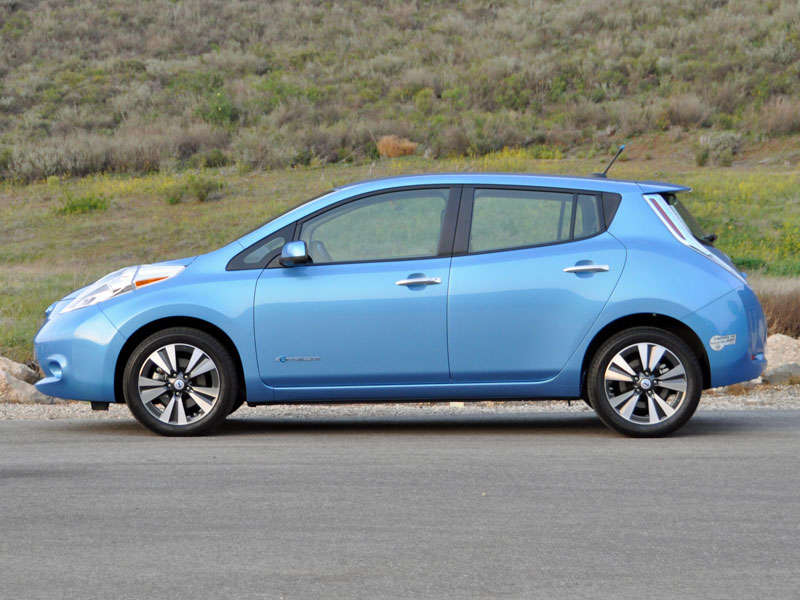Recent Articles
Popular Makes
Body Types
2014 Nissan Leaf Review and Road Test
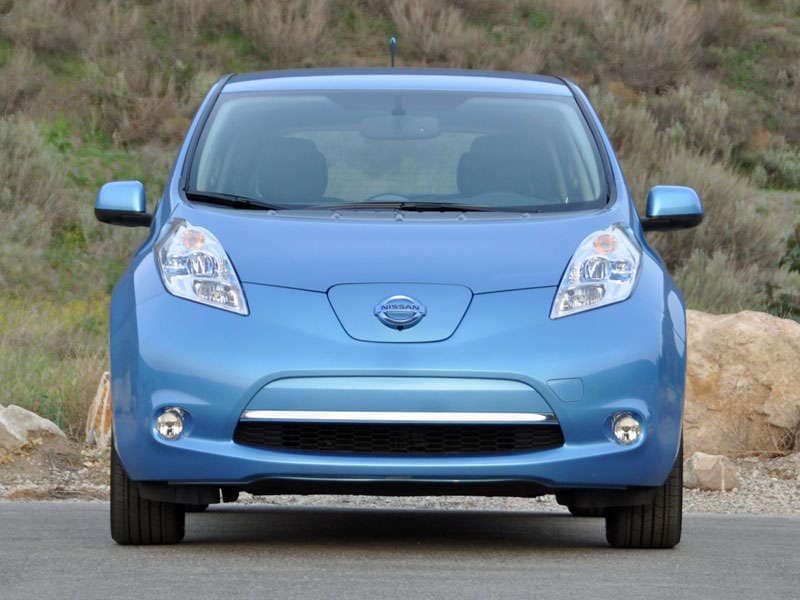
Don’t tell Tesla founder Elon Musk, but electric cars that must be plugged in to recharge the battery represent nothing more than a bridge to a hydrogen-powered fuel-cell future that needs nothing more than a robust infrastructure to become a reality. As such stopgap measures go, the 2014 Nissan Leaf is an excellent example of affordable, electric-only transportation, a comfortable and refined daily driver that makes perfect sense for people who live predictable, regimented lives.
If that’s not you, I strongly advise owning a gasoline-powered vehicle in addition to a Leaf, or adding a membership with a rental car agency. That’s because anytime you need to travel farther than 84 miles without taking a potentially lengthy break from driving, you’re going to want to be burning unleaded instead of using electricity.
2014 Nissan Leaf Review and Road Test: Models and Prices
According to the government, the 2014 Nissan Leaf is a midsize electric vehicle, the only one available by EPA standards of measurement. A Tesla Model S is larger, a Honda Fit EV is considered to be a station wagon (!?), and a Toyota RAV4 EV is an electric SUV. Everything else is smaller.
You can buy a Nissan LEAF S for $29,830, including the $850 destination charge. The federal government gives Leaf buyers a $7,500 income tax credit, and some state and local governments further sweeten the pot. For example, in California, until funds run out, the electric vehicle purchase rebate is $2,500. Combine them, and that’s 10 grand off the sticker. Plus, in Cali, the Leaf can be driven in the carpool lanes, no questions asked.
The only option Nissan offers for the Leaf S is a Charge Package ($1,250) that includes a more powerful 6.6 kW onboard charger and a Quick Charge port that is compatible with public DC Fast Charger systems. Considering that it takes only 20 minutes to reach an 80-percent charge using a fast charger, the extra expense is probably worth it.
Upgrade to the Leaf SV ($32,850) in order to enjoy an infotainment system with a 7-inch touchscreen display, a navigation system, real-time traffic and weather, additional stereo speakers, access to Pandora Internet radio, and Nissan’s CarWings service program complete with a mobile application for your smartphone. Additionally, the SV model features seat cloth partially created from recycled materials, an auto-dimming rearview mirror, cruise control, and 16-inch aluminum wheels. A 6.6 kW onboard charger and a hybrid heater system are also standard for the Leaf SV, along with a B-mode regenerative braking feature that the driver manually activates to increase energy capture and extend driving range.
Two options are available for the Leaf SV. The LED Headlights and Quick Charge Port Package ($1,630) is self-explanatory, except for the fact that it also includes fog lights. A Premium Package ($1,050) is also available, adding a Bose premium audio system and an Around View Monitor that provides a top-down, 360-degree view of the Leaf and its surroundings in order to make maneuvering easier.
The Leaf SL ($35,870) includes the automatic LED headlights, the fog lights, and the Quick Charge Port, enhancing these features with leather seats, a universal garage door opener, a cargo cover, and 17-inch aluminum wheels. The SL trim level also adds a super-cool photovoltaic solar panel rear spoiler. The Premium Package is optional for this model, too.
My test car is the Leaf SL with the Premium Package, painted Blue Ocean with Black leather, and wearing a window sticker reading $36,920 before applying credits, rebates, etc. In my home state of California, these effectively drop the price to $26,920. And if I can find a leftover 2013 Leaf SL in stock, Nissan is providing an additional $2,500 rebate and no-interest financing for 72 months. That effectively makes the monthly payment less than $340 per month.
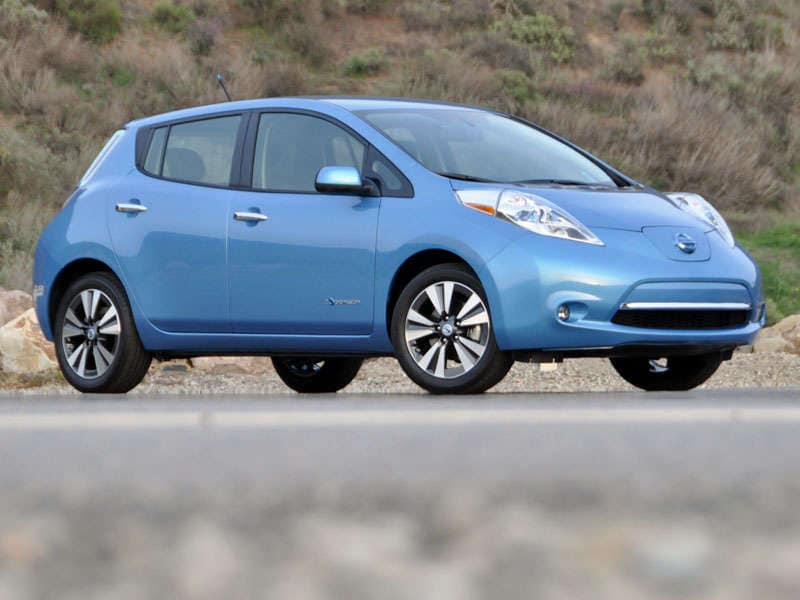
2014 Nissan Leaf Review and Road Test: Design
- No changes for 2014
A Nissan Leaf is not an attractive car, equipped with a shape dictated by a wind tunnel rather than aesthetics, but there is genuine style evident in the artfully shaped headlights, the upswept greenhouse, the sleek and curvaceous rear pillars, and the wispy thin taillights. Even the Leaf SL model’s 17-inch wheels are chic.
In my opinion, the Leaf’s least appealing aspect is in profile because there’s a bunch of front overhang and the enormous headlights exacerbate the issue. Form follows function with a car like the Leaf, which was designed to be nothing more than an electric vehicle, and the result is a low coefficient of drag measuring 0.28 cd.
Inside, the Leaf is conservatively styled, even upscale in SL trim. Decked out with leather seats and Piano Black accents, my Leaf SL test car’s floating tablet-style control panel looked very Apple-ish, a theme extended to the Palm Drive transmission selector on the center console. Hard plastic rules inside of the Leaf, but thanks to tasteful textures and gloss levels it avoids looking cheap. Choose the Leaf SV, and the seat cloth includes recycled materials, appealing to the eco-geek in all of us.
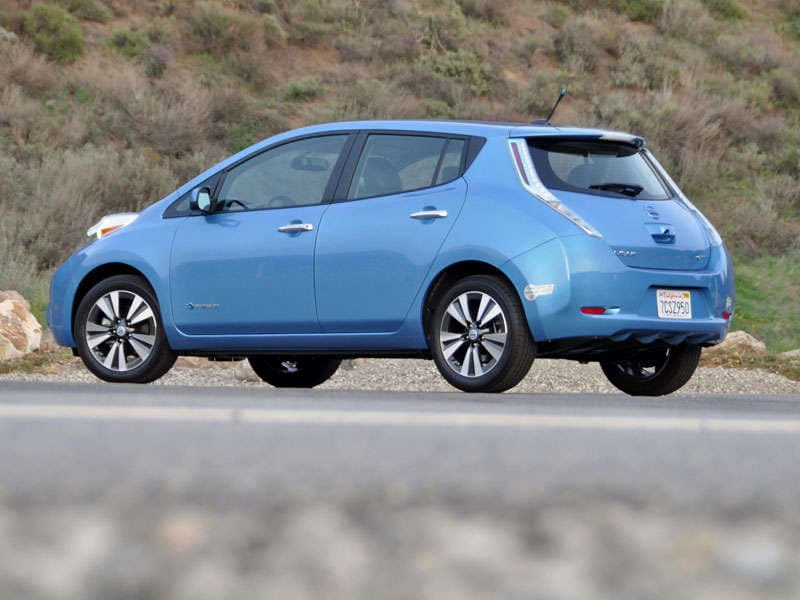
2014 Nissan Leaf Review and Road Test: Comfort and Cargo
- No changes for 2014
The 2014 Nissan Leaf is a roomier car than most people might guess, equipped with comfortable seating for four adults, or even five if the people in the back seat are smaller in stature.
Because the Leaf’s battery is mounted under the seats, the seat cushions sit tall off the floor providing a commanding view out. Getting in and out is really easy, comfort is no problem over the course of the Leaf’s maximum range, and rear occupants enjoy terrific thigh support and good space for legs. Foot room is tight, though. Better yet, every 2014 Leaf is equipped with heated front and rear seats, a heated steering wheel, and automatic climate control.
Got stuff to carry? No problem. Measured to the ceiling, the Leaf’s 23.6 cu.-ft. of cargo space behind the rear seat is quite generous, but the charge cord storage bag chews some of that up, as does the optional Bose premium audio system’s subwoofer. Fold the rear seatbacks flat and cargo space increases incrementally to 30 cu.-ft. Because the resulting load floor isn’t flat, this configuration is best only for carrying longer, flatter objects.

2014 Nissan Leaf Review and Road Test: Features and Controls
- Voice destination programming
- Text message receipt and display
Considering its status as an alternative powertrain vehicle, the Nissan Leaf’s interior is conventional in terms of layout and simple to operate in terms of usability. The Palm Shift drive selector takes some getting used to, but otherwise this is a remarkably easy car to figure out.
Standard equipment for all models includes Nissan Intelligent Key with push-button starting, Bluetooth connectivity, satellite radio, a USB port, an iPod connection, and an auxiliary audio input jack. Upgrade to the Leaf SV or SL model for an infotainment system with a 7-inch touchscreen and CarWings service technology.
CarWings helps to make life with an electric car a little easier. Most important, it can help the driver to find nearby charging stations, and quickly program the navigation system to guide the driver there. A driving range screen shows on the navigation map how far the car can go on its remaining charge, and how much further the Leaf can travel if the climate control system is shut off.
A mobile application is available for the system, allowing the owner to remotely start charging and monitor progress, to program charging times to take advantage of off-peak electricity rates, and to pre-condition the cabin with heat or air conditioning while the Leaf is still plugged into the grid. You can even set the CarWings system up to issue an email when charging is complete.
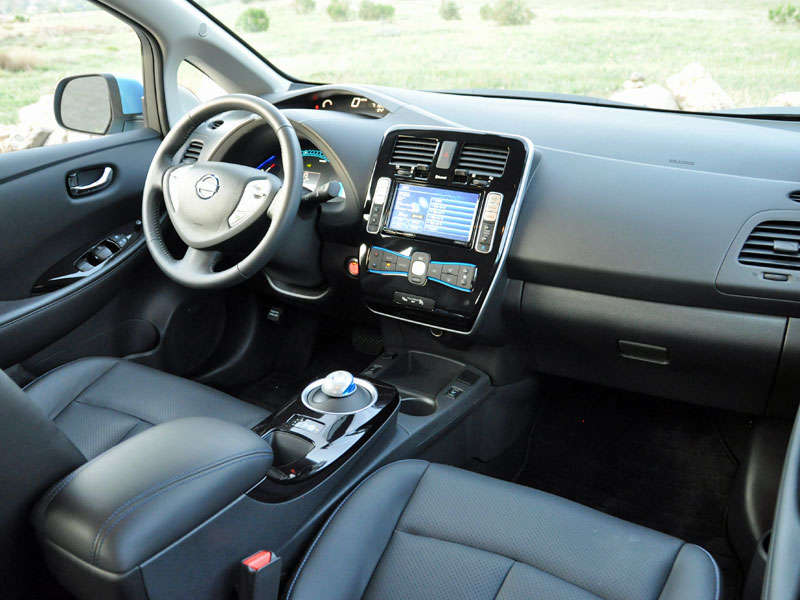
2014 Nissan Leaf Review and Road Test: Safety and Ratings
- Standard reversing camera
When it comes to safety, the Nissan Leaf provides mandated equipment plus a reversing camera and a tire pressure monitoring system with Easy Fill Tire Alert. I’m a big fan of Nissan’s Easy Fill Tire Alert system, because it makes keeping your tires inflated to the proper pressure very simple and easy. Attach the air hose, add air, and the horn chirps when the proper tire pressure is reached.
As an option, the Leaf SV and SL are offered with an Around View Monitor system as a part of the Premium Package. This gives the driver a top-down view of the Leaf and its surroundings, helping to make it easier to park and maneuver the car in tight quarters.
The Insurance Institute for Highway Safety (IIHS) gives the Nissan Leaf its highest rating of “Good” in four out of five crash-test assessments. The Leaf hasn’t been subjected to the fifth test, the small overlap frontal-impact evaluation, as this review is written.
In crash tests conducted by the National Highway Traffic Safety Administration (NHTSA), the Leaf earns an overall rating of 4 stars. The score isn’t higher because the car gets a 3-star rating for the front passenger in the frontal-impact test and a 3-star rating for the rear-seat, side-impact test.
Those two latter scores represent good reason to reconsider purchasing a Leaf, though an electric car buyer’s options are admittedly limited.
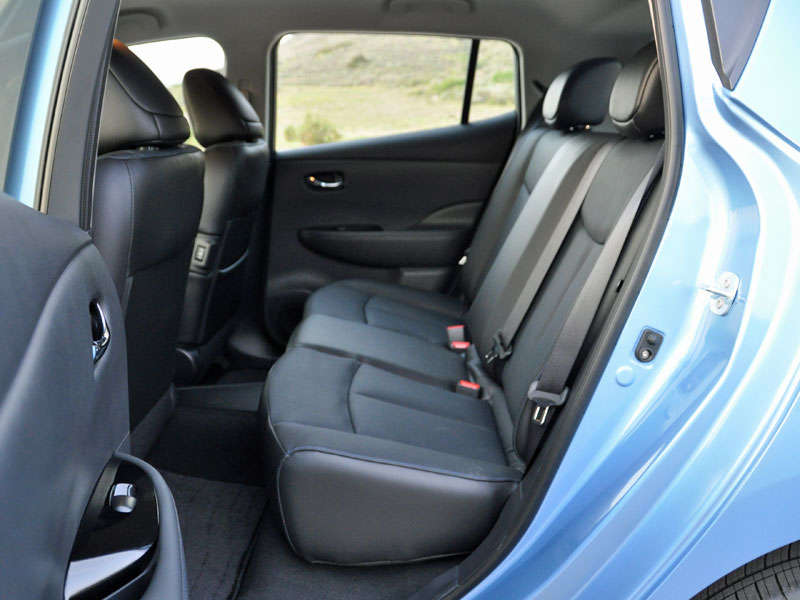
2014 Nissan Leaf Review and Road Test: Engine and Efficiency
- No changes for 2014
More than any other aspect of the Nissan Leaf, it is the car’s electric powertrain that requires the most acclimation by a person new to the technology. It’s not like a traditional gasoline-fueled car, and it’s not like the golf cart you might rent at the course. Believe it or not, a Leaf feels most like an electric indoor racing kart.
That’s not a joke. Stop laughing. Seriously.
Look, with a 90-mph top speed, I will grant you that this isn’t a performance car. But the 107-horsepower, 80-kW electric motor makes its 187 lb.-ft. of torque the moment you step on the accelerator pedal, and if the Leaf’s Eco driving mode is disabled, the 3,242-pound electric car feels quick and lively. Better yet, the weight of the 24 kWh lithium-ion battery is snugged down low in the Leaf’s chassis, giving the car a reduced center of gravity, which makes it feel far more responsive than you might expect.
Eventually, though, the fun comes to an end, and you’ve gotta plug the Leaf in to recharge the battery. A trickle-charge cable is standard equipment, compatible with a typical household power outlet. Using this solution, it takes a really long time to recharge a fully depleted Leaf battery. That’s why people with longer commutes will want to install a 240-volt home quick charger ($1,999 installed), which does the deed overnight while you sleep. You could even hook the home charger up to its own solar panel, making the Leaf an even more environmentally responsible choice.
As a side note, I’m not a fan of the Leaf’s standard charge cord. First, it needs some kind of a caddy or reel to make gathering it up and storing it an easier process. Second, the black rubber cord is going to get dirty, so wearing a pair of gloves is a good idea. Also, when the Leaf is locked, it’s easy to remove the charger without any kind of penalty, something that could happen at a public charging station. Try that with a Chevy Spark EV and the horn honks until you unlock the doors, discouraging would-be public charger thieves.

2014 Nissan Leaf Review and Road Test: Driving Impressions
I’ve already likened the Nissan Leaf’s instantaneous torque and low center of gravity to an electric indoor racing kart, so you probably know where this “driving impressions” section is going. Before we get into the details, though, let me explain that this car has a split personality.
With the Eco driving mode engaged, the Leaf feels slow and dull-witted, and the faster you drive it the more difficult it is to maintain a specific speed. The effect is like driving a car with the emergency brake partially engaged. Turn the Eco driving mode off, and the car is transformed into an eager and energetic runabout, one that readily responds to throttle inputs and effortlessly zooms to speed.
No matter which driving mode is engaged, the Leaf strikes me as a refined vehicle, one that does a good job of masking the added weight of its battery. All that extra weight sits low in the Leaf’s chassis, helping it to feel better planted to the road whether traveling in a straight line or taking a corner. As a function of its weight and how it sits in the car, the Leaf’s ride quality is firm and connected but not harsh, the car hobby-horsing a bit over undulating pavement not unlike a Porsche Boxster.
My Leaf SL’s 17-inch wheels and P215/50R17 Michelin Energy Saver tires didn’t hesitate to grip the pavement with gusto, helping to contribute a slot-car feel to the handling, and the electric steering offered impressive heft and accuracy if not genuine feel for the road. While tossing the car down a country road dappled in spring sunlight, I found the Leaf to be genuinely fun to drive.
It’s entertaining to demonstrate how quick it is, too. Most people pull up behind this car, with its California carpool lane stickers and “I’m Green!” styling and automatically assume they’re going to get stuck behind some slow poke. As long as the Eco driving mode is shut off, when the light turns green and you push down on the accelerator the Leaf literally leaps forward, certainly surprising some folks who draw inaccurate conclusions about the car, and its driver.
Beyond acceleration and handling, the Leaf’s regenerative brakes are terrific, providing an unusual degree of natural pedal feel and ease of modulation for this kind of system. In SV and SL models, the Palm Drive transmission selector also offers a Braking mode that the driver can engage when coasting down a steep hill or approaching a stop, feeding additional energy captured from the braking process to the battery to help replenish it on the fly.
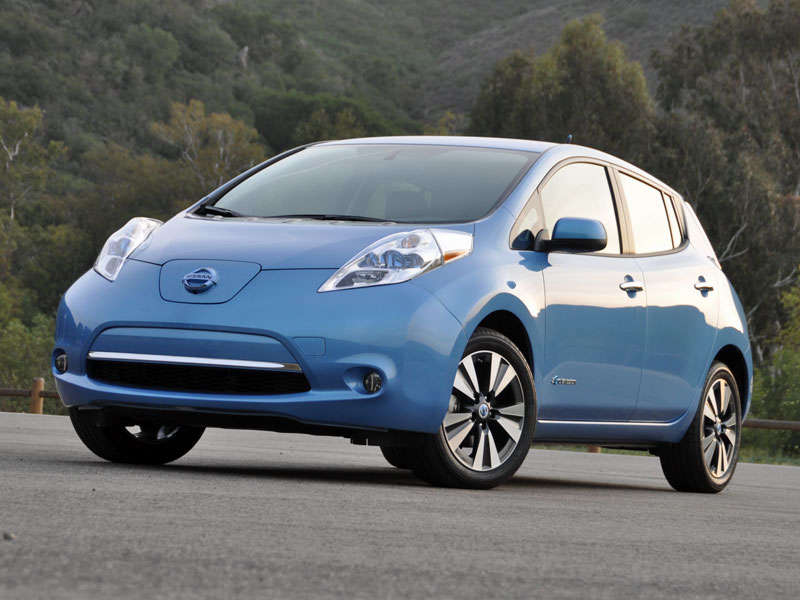
2014 Nissan Leaf Review and Road Test: Real Life Drama
Here’s a perfect example illustrating why you might not want to rely solely on a Nissan Leaf for transportation. During my week with this electric car, by family decided to spend a day at Disneyland, which is 70 miles from our house. Given the Leaf’s 84-mile range, the distance wasn’t a problem, though coming home would involve an ascent in elevation that could create serious range anxiety.
That’s not why we decided to leave the Leaf parked in our driveway, though. Neither was the decision driven by concern over re-charging the battery, because Disneyland has installed new charging stations in its main parking structure. Rather, the reason we decided to drive something else was related to the route.
The shortest path from Casa Wardlaw to Disneyland is to drive straight through downtown Los Angeles and to Orange County on Interstate 5 south. There are no carpool lanes on this route, and if you’re heading that direction on a weekday morning, you want a carpool lane. Therefore, the route down I-405, which has carpool lanes, adds mileage to the trip, making it difficult to reach Disneyland on a single battery charge.
My family decided to drive something else that day. Good thing, because when we arrived at the park, the main parking structure with the EV charging stations was closed, and we were forced to park waaaaaaay out by the Disneyland Hotel. Had I rolled up in the Nissan Leaf, running on electrical fumes and expecting to re-charge inside the garage only to be turned away toward a different lot, I would not have been the happiest of campers.
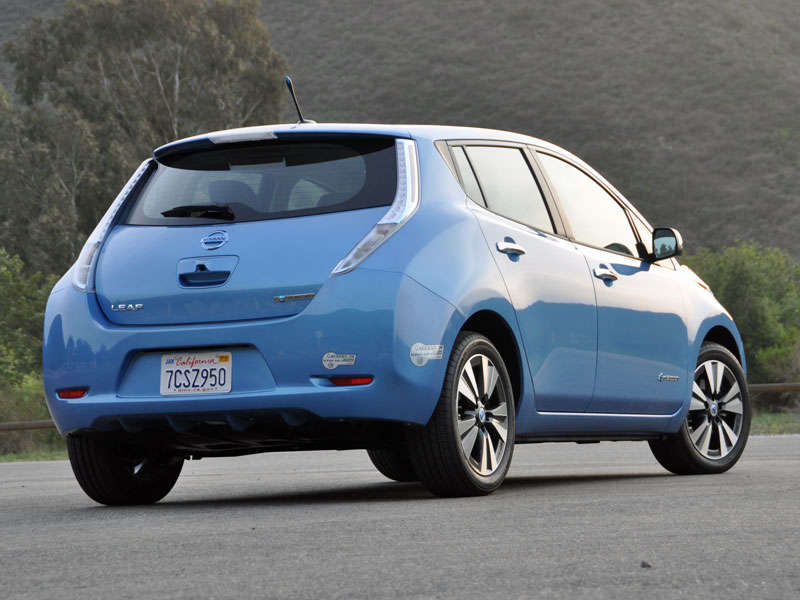
2014 Nissan Leaf Review and Road Test: Final Thoughts
While it’s true that the nation’s electric vehicle charging infrastructure has grown dramatically since the Nissan Leaf first went on sale in 2011, it still isn’t easy using an electric car as your sole method of transportation. People who rent their dwellings certainly face challenges, and that represents more than a third of the nation’s population. People who don’t plan ahead or pay attention may find themselves stranded, too, and any time anything unexpected occurs it can really cause problems.
As much as I like the Nissan Leaf, and as practical a daily-driver as it is, it possesses the potential to complicate rather than simplify life for people who don’t have a Plan B that’s ready to roll at a moment’s notice. So make sure that you’ve always got a backup plan before going electric with the Leaf, or, for that matter, any other EV.
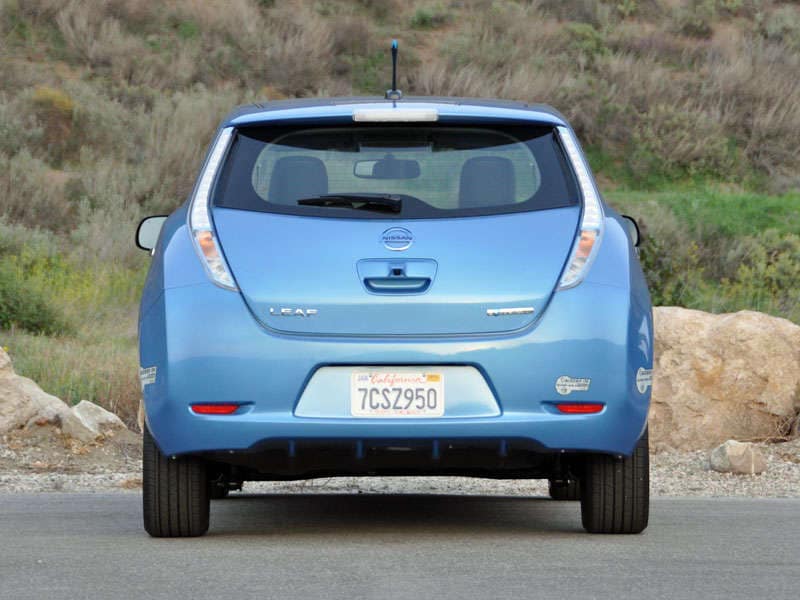
2014 Nissan Leaf Review and Road Test: Pros and Cons
- Zero emissions from car
- Quick acceleration, lithe handling
- Comfortable, quality cabin
- Lots of trunk room, hatchback utility
- CarWings technology
- Range limitations
- Finding available charging stations
- Waiting for battery to re-charge
- Unimpressive NHTSA crash-test ratings
- Love-it-or-hate-it styling
Nissan supplied the vehicle for this review
2014 Nissan LEAF photos by Christian Wardlaw
